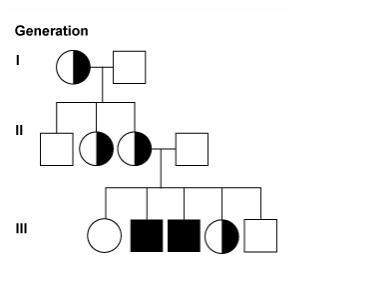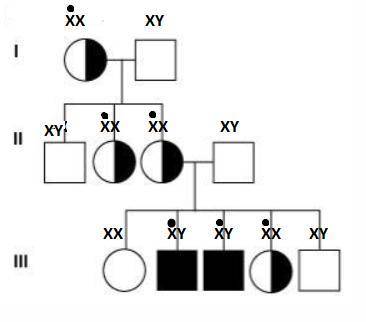
Chemistry, 27.08.2019 23:10 nyceastcoast
Refer to the figure showing a pedigree of a family affected by an x-linked recessive disorder. a female in generation 3 isn't a carrier of the disorder. how can this be?
a. females receive x chromosomes from this fathers only, which are unaffected in this case.
b. females don't have x chromosomes so aren't affected by gene disorders passed on the x chromosome.
c. females receive an x chromosomes from each point parent, but in cases of recessive disorders, the muted chromosome isn't passed on to daughters.
d. females receive an x chromosome from each parent. if a mother is a carrier of an x-linked recessive disorder, her daughters have 50 percent chance of receiving her normal x chromosome and a 50 percent chance of receiving her mutated x chromosome.


Answers: 1
Another question on Chemistry


Chemistry, 22.06.2019 05:20
Identify and describe the three ways that mutations affect organisms.
Answers: 1

Chemistry, 22.06.2019 17:40
Experiment: effect of solution concentration on reaction rate you have learned that as the concentration of reactants increases, there will most likely be a greater number of collisions, and hence increase the rate of a reaction. in this experiment, you will see a demonstration of this, with a twist. there will be three reactions going on in this experiment. objectives determine how solution concentration can affect the rate of a reaction. the first reaction will be a reaction of the iodide ion (i-1) with hydrogen peroxide (h2o2) in an acidic solution. this reaction produces a slightly orange solution. in our experiment, we will add some orange food coloring to make this solution more orange. 2 h+ (aq) + 2 i- (aq) + h2o2 (aq) ⟶ i2 (aq) + 2 h2o (l) the next reaction will be between the iodine and starch i2 + starch ⟶ i2-starch complex (blue-black) so, when starch is added to the iodine solution made from the first reaction, the solution will turn black immediately, so it is difficult to find the rate of reaction. in order to be able to time this reaction, you will slow it down with another reaction. adding ascorbic acid will react with the iodine, reducing the concentration of the iodine available to react with the starch. c6h8o6 (aq) + i2 (aq) ⟶ 2i- (aq) + c6h6o6 (aq) + 2 h+ (aq) when the ascorbic acid is used up, the remaining iodine molecules can react with the starch and form the black color. the more ascorbic acid you add, the slower the reaction to form the iodine-starch complex will be. use your data and observations to complete the assignment. analysis and conclusions submit your data and the answers to these questions in the essay box below. what was your hypothesis? plot your data as drops of ascorbic acid vs. time. as the concentration of ascorbic acid was increased, did the rate of the formation of the iodine-starch complex increase or decrease? explain your answer in terms of the chemical reactions involved. was your hypothesis correct? make a general rule about the effects of concentration of reactants on reaction rates. for practice, the molecular formula for ascorbic acid is c6h8o6, and you used 6 g in this experiment, calculate the molarity of the ascorbic acid. now calculate the concentration in moles per drop (assume 1 ml = 20 drops).
Answers: 3

Chemistry, 22.06.2019 20:30
Which states of matter have particles that move independently of one another with very little attraction?
Answers: 1
You know the right answer?
Refer to the figure showing a pedigree of a family affected by an x-linked recessive disorder. a fem...
Questions

Chemistry, 03.10.2019 05:00

Social Studies, 03.10.2019 05:00

English, 03.10.2019 05:00

Biology, 03.10.2019 05:00

Biology, 03.10.2019 05:00


Mathematics, 03.10.2019 05:00

Mathematics, 03.10.2019 05:00


Chemistry, 03.10.2019 05:00

English, 03.10.2019 05:00

Biology, 03.10.2019 05:00




History, 03.10.2019 05:00


Social Studies, 03.10.2019 05:00





